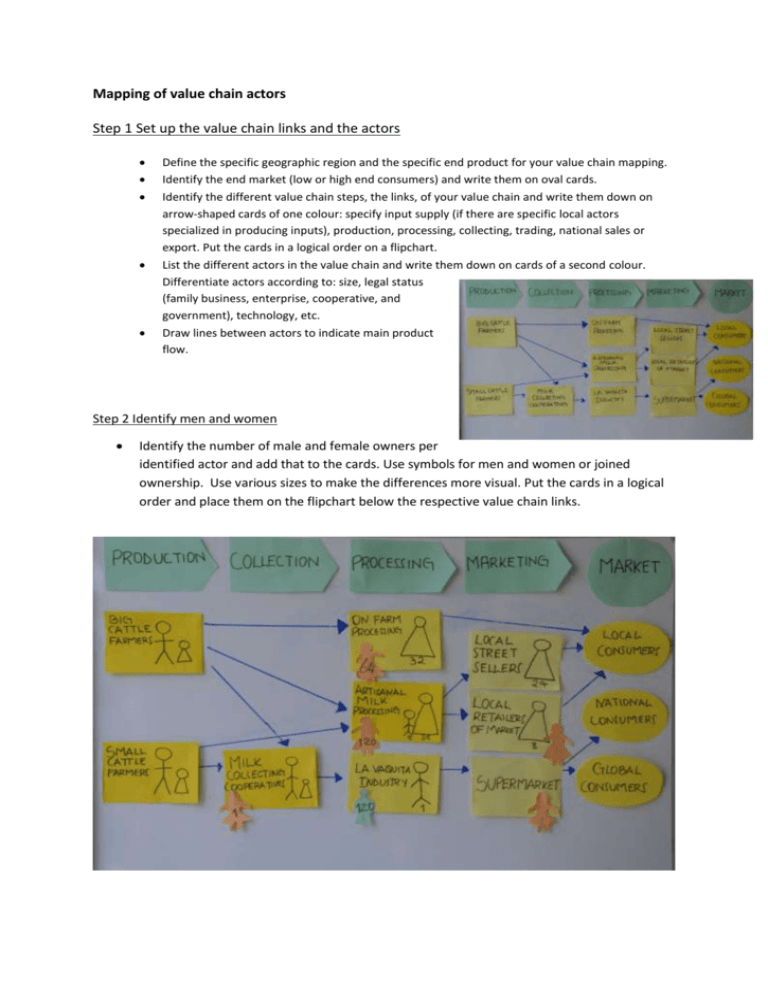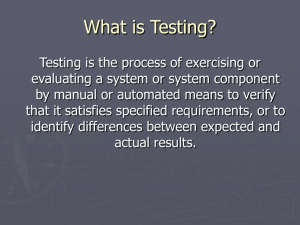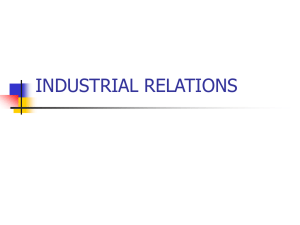Mapping of value chain actors Step 1 Set up the value chain links
advertisement

Mapping of value chain actors Step 1 Set up the value chain links and the actors Define the specific geographic region and the specific end product for your value chain mapping. Identify the end market (low or high end consumers) and write them on oval cards. Identify the different value chain steps, the links, of your value chain and write them down on arrow-shaped cards of one colour: specify input supply (if there are specific local actors specialized in producing inputs), production, processing, collecting, trading, national sales or export. Put the cards in a logical order on a flipchart. List the different actors in the value chain and write them down on cards of a second colour. Differentiate actors according to: size, legal status (family business, enterprise, cooperative, and government), technology, etc. Draw lines between actors to indicate main product flow. Step 2 Identify men and women Identify the number of male and female owners per identified actor and add that to the cards. Use symbols for men and women or joined ownership. Use various sizes to make the differences more visual. Put the cards in a logical order and place them on the flipchart below the respective value chain links. Step 3 Identify paid and unpaid labour Identify which actors contract hired labour. Make cards of a third colour to write down the numbers of men and women employed. Differentiate where needed between permanent and seasonal labour. Identify where women provide unpaid family labour, working on the family farm with little or no control of coffee income, and add it to the map. There is some missing information about the labour done by women and man and who is paid and who is not paid.(For the cut out men and women) We added ‘’unpaid women’’ at the step of production but they can also be at other steps like in the on farm processing and the artisanal processing. Step 4: Mapping of support services Identify the support services for the value chain actors at the different stages of the value chain. Write them down on cards of another colour. Examples of supporting service providers are extension services, certification services, financial services (saving, credit and insurance) and business development services such as market information, trade facilitation, business management, brand development and quality assurance. Reflect also services that can alleviate women’s reproductive workload, such as childcare services. Mieke, could you provide a sketch for this also? Step 5: Opportunities and constraints for women at support service level Identify opportunities and constraints women face in accessing and benefiting from services that support their performance and improve value chain coordination and upgrading. Write main opportunities and constraints on cards. Mark opportunities with a + and constraints with a – sign. Guiding questions are: What is the percentage of women and men served by these service providers? Do women working on farms owned by their spouses receive extension or credit services? Do female workers access job training? Are services designed considering specific needs and conditions of women like domestic obligations and time constraints, limited mobility and market networking, limited property as collateral for loans, etc.? What are the main constraints women face in accessing supporting services? Which services present opportunities to improve the position of women in the value chain? Identify important factors that affect the role and position of women in the value chain like land and property rights, infrastructure, public policies, labour policies, gender roles and stereotypes, certification standards and regulations, consumers trends, women’s Mieke, could you provide a sketch for this also? Step 6: Opportunities or constraints for women empowerment in value chain development The next step is to identify opportunities and constraints for women empowerment in the value chain. Write them on cards and mark them with + and – signs. Guiding questions are: How do cultural and/or legal norms influence land ownership practice? How does this influence women’s access to membership of farmer organizations and connected services? How do social stereotypes influence opportunities and benefits for women in the value chain, including paid labour? Mieke, could you provide a sketch for this also? How does this influence the presence or absence of women in specific parts of the value chain, and appreciation and reward for their contributions? How does this affect value chain upgrading, improving productivity, quality and management of the value chain? What constraints and opportunities do women have to upgrade/improve their position in the value chain, for instance increase decision-making and control of coffee income on family farms, improve employment conditions, or gain access to staff or management positions? Do standards and certification pay sufficient attention to the role and position of women? Mieke, could you provide a sketch for this also?





